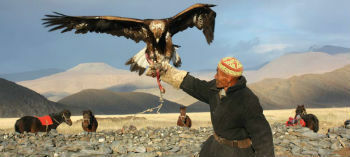THE Mongolia is a country in East and Central Asia.
In the Middle Ages, led by Genghis Khan, it constituted the largest empire with the territory extending from the Korean peninsula to Europe.
It currently borders two countries: China, to the south and Russia, at North.
General data

Mongolia Map
- Capital: Ulan Bator (or Ulaanbaatar)
- Territorial extension: 1 564 116 km²
- Inhabitants: 3 million
- Climate: continental temperate
- Gentile: Mongolian
- Language: Mongolian
- Religion: Predominates Buddhism and shamanic practices.
- Currency: Tugrik
- Political System: Semi-presidentialism, multi-partyism
Flag

Mongolian Flag
The Mongolian flag is divided into three vertical bands: two red sides and a blue middle one. In the stripe on the left corner there is a drawing that refers to the country's history and culture.
Red would represent progress and prosperity, while blue symbolizes the eternal sky that covers the region. It was also the color that belonged to the Khans (Emperors) Mongols.
The drawing is an icon called Sojombo. This design brings together different geometric shapes that make reference to fire, sun, moon, earth, water and the yin-yang symbol.
In this way, the ancient Mongols used them to spread wisdom, freedom, the desire for peace and justice.
Cities
- Ulan Bator - capital of the country
- bulgan
- Altaj
- Ulaangom
- raind
- Coljbalsan
- vörkhangay
- Dalanzadgad
- Moron
- Olgiy
Economy
Mongolia is poor in fertile land and the harsh climate does not help cultivation. For many years, herding was the main activity.
Currently, many inhabitants temporarily immigrate to Taiwan, South Korea and China in order to work.
The capital is home to 45% of the country's population and increasingly, nomads abandon their ancestral way of life to settle in Ulan Bator.
Currently, tourism has attracted visitors in search of lush landscapes, rich nature and spirituality reborn after the fall of communism.
History
The current territory of Mongolia was occupied by different nomadic tribes. The leader of one of them, Genghis Khan, he imposes himself as a warrior who was able to unite them around a common goal. Thus, it forms a powerful army that conquered and maintained a considerable territorial extension that included China.
In turn, after the death of the grandson of Genghis Khan, the Empire is constantly attacked by the Chinese until they are absorbed by them. Independence from China would only take place in 1921.
After the end of World War II, the country would pass to Soviet influence adopting socialism and even the Cyrillic alphabet to write its language.
With the collapse of USSR, Mongolia abruptly switches from the planned and state economy to the market economy in 1992.
Currently, what you see is a country full of contrasts between tradition and modernity, poverty and wealth.
Most of the inhabitants are poor and live on $1.95 dollars a day.
Culture

The Eagle Festival is celebrated during the month of October in Olgii, Mongolia
Mongolian culture is rich in traditions and is centered on the nomadic life of its inhabitants.
Hospitality is strictly observed and visitors are surprised by the kindness in which they are received and the abundance of food.
Nature occupies a central place, as the country has high mountains, steppes and the largest desert in Asia. In this way, the horse and the eagle became human companions in order to help them in displacement and hunting.
Parties
One of the biggest Mongolian festivals is dedicated to the eagle. Hunters across the country show their skill in hunting with this animal. There are also horse races and various disputes during the celebration.
The most popular festivals in the country are the Mongolian New Year celebration "Tsagaan sar" in January and February. Also in July there is the National Party, "Naadam", celebrated on the 11th, 12th and 13th.
Curiosities
- Among the Kazakhs, one of the ethnic groups that populate Mongolia, women prepare food, but only men can cut the meat.
- Due to Soviet and even Chinese influence, chess is a popular sport in the country.
- The Mongolian squirrel lives in the country's desert and is considered a pest. However, it is becoming more and more popular among Westerners as a pet.
- Mongolia is the country with the largest temperature range in the world, that is, where there is the largest difference between maximum and minimum temperature
read more:
- ancient china
- Asia
- Buddhism



